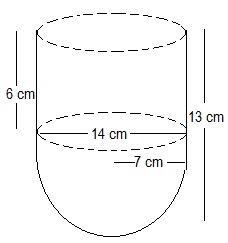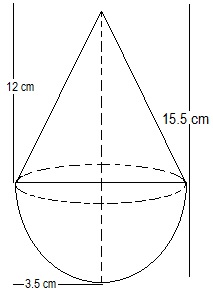NCERT Solutions for Class 10th: Ch 13 Surface Areas and Volumes Maths
Page No: 244Exercise 13.1
Unless stated otherwise, take π = 22/7.
1. 2 cubes each of volume 64 cm3 are joined end to end. Find the surface area of the resulting cuboid.
Answer

⇒ a3 = 64 cm3
⇒ a = 4 cm
Side of the cube = 4 cm
Length of the resulting cuboid = 4 cm
Breadth of the resulting cuboid = 4 cm
Height of the resulting cuboid = 8 cm
∴ Surface area of the cuboid = 2(lb + bh + lh)
= 2(8×4 + 4×4 + 4×8) cm2
= 2(32 + 16 + 32) cm2
= (2 × 80) cm2 = 160 cm2
2. A vessel is in the form of a hollow hemisphere mounted by a hollow cylinder. The diameter of the hemisphere is 14 cm and the total height of the vessel is 13 cm. Find the inner surface area of the vessel.
Answer

Radius of the hemisphere(r) = 7 cm
Height of the cylinder(h) = 13 - 7 = 6 cm
Also, radius of the hollow hemisphere = 7 cm
Inner surface area of the vessel = CSA of the cylindrical part + CSA of hemispherical part
= (2πrh+2πr2) cm2= 2πr(h+r) cm2
= 2 × 22/7 × 7 (6+7) cm2= 572 cm2
3. A toy is in the form of a cone of radius 3.5 cm mounted on a hemisphere of same radius. The total height of the toy is 15.5 cm. Find the total surface area of the toy.
Answer

Total height of the toy = 15.5 cm
Height of the cone(h) = 15.5 - 3.5 = 12 cm
Curved Surface Area of hemisphere = 2πr2 = 2 × 22/7 × (7/2)2 = 77 cm2
Total surface area of the toy = CSA of cone + CSA of hemisphere = (275/2 + 77) cm2
= (275+154)/2 cm2 = 429/2 cm2 = 214.5 cm2
The total surface area of the toy is 214.5 cm2
4. A cubical block of side 7 cm is surmounted by a hemisphere. What is the greatest diameter the hemisphere can have? Find the surface area of the solid.
Answer
∴ Radius of the hemisphere = 7/2 cm
Total surface area of solid = Surface area of cubical block + CSA of hemisphere - Area of base of hemisphere
TSA of solid = 6×(side)2 + 2πr2 - πr2 = 6×(side)2 + πr2 = 6×(7)2 + (22/7 × 7/2 × 7/2)
= (6×49) + (77/2) = 294 + 38.5 = 332.5 cm2
The surface area of the solid is 332.5 cm2
5. A hemispherical depression is cut out from one face of a cubical wooden block such that the diameter l of the hemisphere is equal to the edge of the cube. Determine the surface area of the remaining solid.
Answer
![]() Diameter of hemisphere = Edge of cube = l
Diameter of hemisphere = Edge of cube = l
Radius of hemisphere = l/2
Total surface area of solid = Surface area of cube + CSA of hemisphere - Area of base of hemisphere
TSA of remaining solid = 6 (edge)2 + 2πr2 - πr2 = 6l2 + πr2
= 6l2 + π(l/2)2 = 6l2 + πl2/4 = l2/4 (24 + π) sq units
6. A medicine capsule is in the shape of a cylinder with two hemispheres stuck to each of its ends. The length of the entire capsule is 14 mm and the diameter of the capsule is 5 mm. Find its surface area.
![]()
![]()
⇒ l = √(12)2 + (3.5)2
⇒ l = √(12)2 + (3.5)2
Go To Chapters
5. A hemispherical depression is cut out from one face of a cubical wooden block such that the diameter l of the hemisphere is equal to the edge of the cube. Determine the surface area of the remaining solid.
Answer
Radius of hemisphere = l/2
Total surface area of solid = Surface area of cube + CSA of hemisphere - Area of base of hemisphere
TSA of remaining solid = 6 (edge)2 + 2πr2 - πr2 = 6l2 + πr2
= 6l2 + π(l/2)2 = 6l2 + πl2/4 = l2/4 (24 + π) sq units
6. A medicine capsule is in the shape of a cylinder with two hemispheres stuck to each of its ends. The length of the entire capsule is 14 mm and the diameter of the capsule is 5 mm. Find its surface area.
Answer
It can be observed from the figure that there are two hemispherical parts with radius = 5/2 = 2.5 mm
Also, there is one cylinder whose radius is equal to the hemisphere and length of the cylinder is (14 - 5) = 9 mm.
Radius (r) of cylindrical part = Radius (r) of hemispherical part =
⇒ l = √(12)2 + (3.5)2
Go To Chapters
















